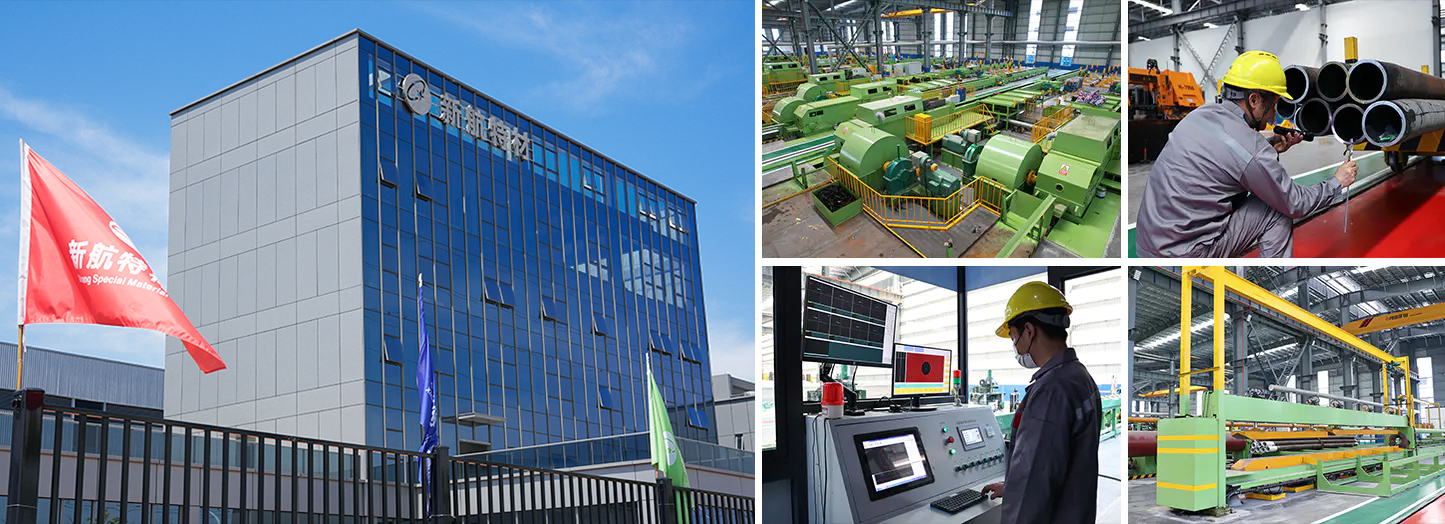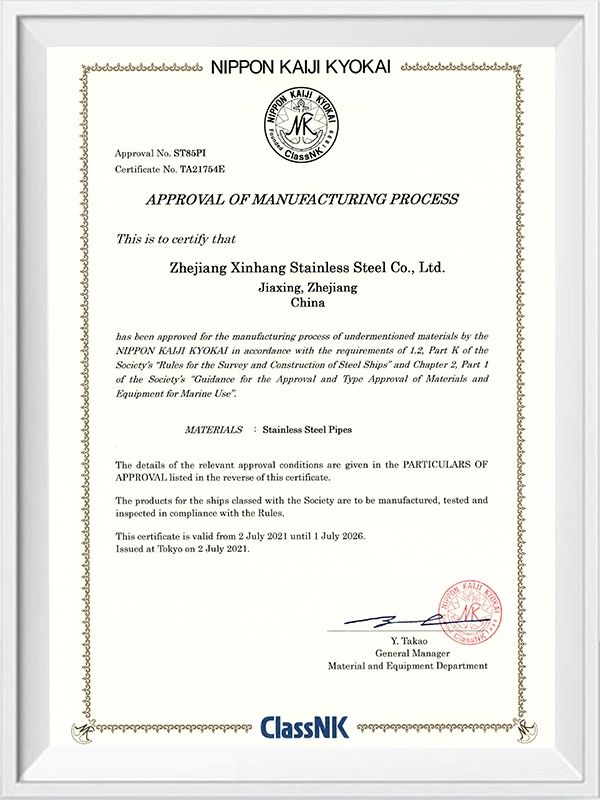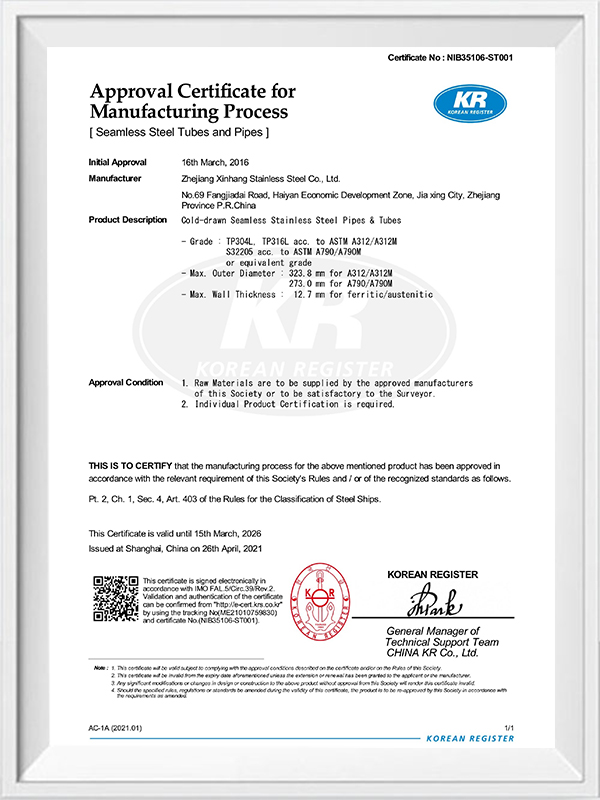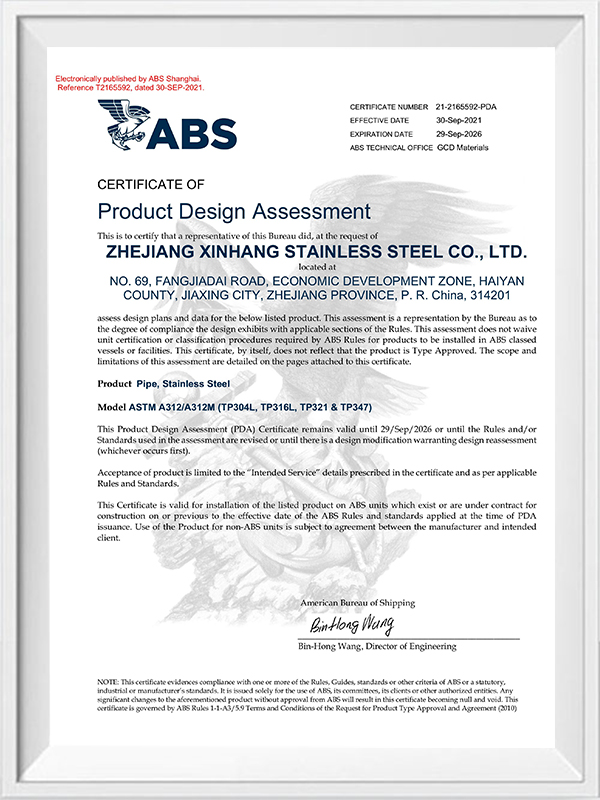

Xinhang Special Material Co., Ltd. Hangzhou Branch is China Stainless Steel Bend Manufacturers and Stainless Steel Bend Factory, founded in 2007 and moved to Longyou Economic Development Zone, Zhejiang Province, in 2022. It covers an area of 130,000 square meters, more than 30 production lines, 300 workers, 20 R&D people, 30 inspection people and an annual output of 50,000 tons.
It has passed ISO9001:2008 quality management system, PED 97/23/EC EU Pressure Equipment Directive certification, China Special Equipment Manufacturing License (Pressure Tube) TS certification, ASME certification, provincial enterprise standardization management system, ISO14000:2004 environment management system, cleaner production (green enterprise), and a series of certifications, as well as China Classification Society (CCS), American Bureau of Shipping (ABS), British Register of Shipping (LR), Deutsche Veritas (GL), Bureau Veritas Society (BV), Det Norske Veritas (DNV), and Korean Register of Shipping (KR) factory certification.
The main products include stainless steel pipes, pipe fittings, flanges, valves, etc., which are widely used in petroleum, chemical industry, nuclear industry, smelting, shipbuilding, pharmaceuticals, food, water conservancy, electric power, new energy, mechanical equipment, and other fields. The company adheres to the corporate tenet of "quality for survival, reputation for development" and wholeheartedly serves every customer to create a win-win situation.




Introduction to Alloy Steel Alloy steel is a type of steel that is made by combining carbon steel wi...
View MoreMass Density of Mild Steel: Basics and Practical Importance The mass density of mild steel is a fund...
View MoreUnderstanding Stress Proof Steel Stress proof steel is a type of alloyed steel engineered to resist ...
View MoreIntroduction to Low Alloy Steel Material Low alloy steel material is a type of steel that contains a...
View MoreOverview — what "weight per cubic inch" means for stainless steel "Weight per cubic inch" is simply ...
View MoreHow do you select the right stainless steel bend for a specific application based on factors like diameter, wall thickness, and bend radius?
Diameter: The diameter of the stainless steel bend should match the diameter of the piping or tubing it will be connected to. Ensure that the bend's diameter is compatible with the flow requirements of the system. Consider factors such as fluid velocity, pressure drop, and flow restrictions when determining the appropriate diameter.
Wall Thickness: The wall thickness of the stainless steel bend is crucial for structural integrity and resistance to internal pressure. It should be sufficient to withstand the operating conditions of the system, including pressure, temperature, and environmental factors. Consult engineering standards or guidelines to determine the minimum required wall thickness based on the application's specifications.
Bend Radius: The bend radius refers to the curvature of the bend and influences fluid flow, pressure drop, and stress distribution. Choose a bend radius that minimizes flow restriction and pressure drop while maintaining structural integrity. Consider the space constraints and installation requirements of the application when selecting the bend radius.
Material Grade: Select a stainless steel grade that offers the desired mechanical properties, corrosion resistance, and temperature resistance for the application. Common grades include 304, 316, and 316L stainless steel, each with its own characteristics suited for different environments and operating conditions.
Manufacturing Process: Consider the manufacturing process used to produce the stainless steel bend, such as seamless bending or welded bending. Seamless bends typically offer smoother internal surfaces and better flow characteristics, while welded bends may be more cost-effective but could have weld-related issues like corrosion or reduced strength.
How do factors like alloy composition, grade, and surface finish impact the performance and suitability of stainless steel bends for different applications?
Factors such as alloy composition, grade, and surface finish play crucial roles in determining the performance and suitability of stainless steel bends for different applications:
Alloy Composition: The alloy composition of stainless steel determines its chemical makeup and influences its mechanical properties, corrosion resistance, and other characteristics. Common alloying elements include chromium, nickel, molybdenum, and titanium. For example:
Chromium enhances corrosion resistance and oxidation resistance.
Nickel improves ductility, toughness, and resistance to high temperatures.
Molybdenum enhances corrosion resistance, particularly in chloride environments.
Titanium stabilizes the structure of stainless steel at high temperatures and improves weldability.
Grade: Stainless steel is available in various grades, each with specific properties tailored for different applications. The choice of grade depends on factors such as corrosion resistance, strength, temperature resistance, and cost. Common stainless steel grades include:
Austenitic stainless steels (e.g., 304, 316) offer excellent corrosion resistance, formability, and weldability, making them suitable for a wide range of applications, including food processing, pharmaceuticals, and chemical processing.
Ferritic stainless steels (e.g., 430) provide good corrosion resistance and high-temperature strength but may have lower ductility compared to austenitic grades. They are commonly used in automotive exhaust systems, appliances, and architectural applications.
Martensitic stainless steels (e.g., 410, 420) offer high strength and hardness but lower corrosion resistance compared to austenitic and ferritic grades. They are commonly used in applications requiring wear resistance, such as cutlery, surgical instruments, and industrial equipment.
Surface Finish: The surface finish of stainless steel bends affects their appearance, cleanliness, corrosion resistance, and ease of cleaning. Common surface finishes include:
Mill finish: The raw, as-produced surface of stainless steel without any additional treatment. It may have a rough texture and is typically used in applications where appearance is not critical.
Polished finish: The surface is mechanically polished to achieve a smooth, reflective surface. It enhances the aesthetics of stainless steel bends and improves corrosion resistance by reducing surface roughness.
Electropolished finish: The surface is chemically treated to remove surface imperfections and contaminants, resulting in a smooth, passive layer that improves corrosion resistance and cleanability. It is commonly used in pharmaceutical, semiconductor, and food processing industries where cleanliness is essential.
We'll never share your email address and you
can opt out at any time, we promise.